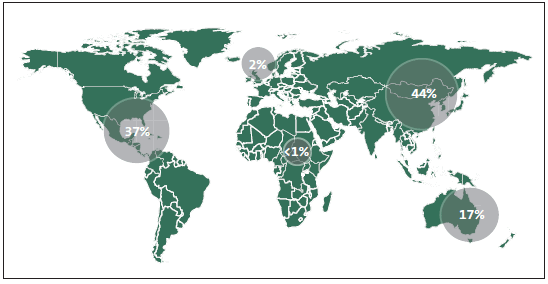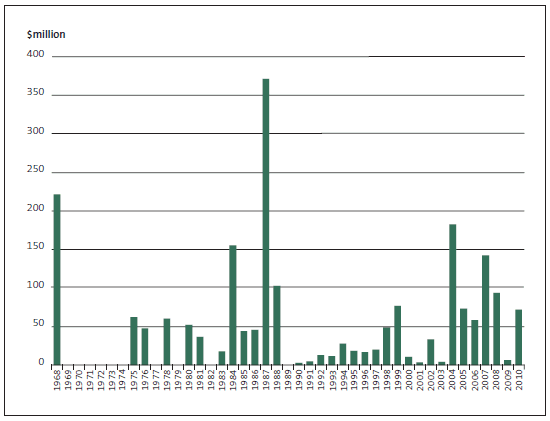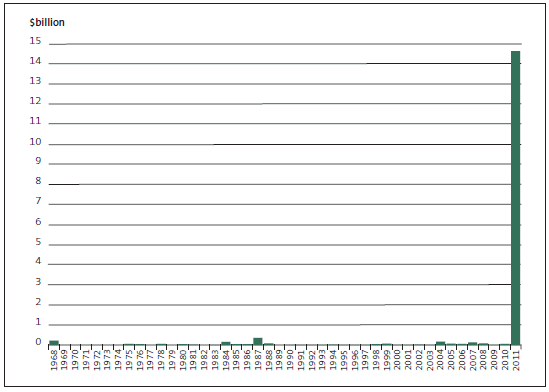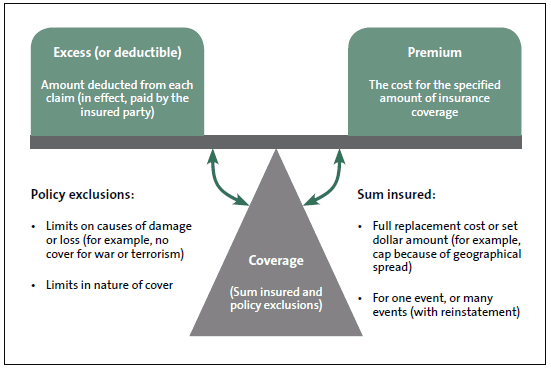Part 1: Introduction
The insurance market
1.1
Insurance is one way to manage the risk of assets not being available in the future to provide services. It manages that risk by transferring some of it to an insurer (an insurance company). The insurance company then typically transfers some of that risk by getting reinsurance, often overseas.
1.2
Recently, the global insurance industry has been put under significant pressure. Natural disasters around the world have resulted in significant insured economic losses. New Zealand's insurance industry is not exempt from the pressure, which has affected New Zealand's reinsurance costs.
1.3
This is because the insurance industry around the world is interconnected. With more reinsurance being acquired from the international market, a disaster event anywhere in the world can affect the cost of insurance in New Zealand. If the cost of reinsurance goes up globally, then insurance companies in New Zealand will pass these costs on through higher premiums.
1.4
Before the Canterbury earthquakes, New Zealand insurers had been getting reinsurance cover at reinsurance rates that reflected the expected risks. Those rates have now increased to better reflect the known earthquake risk. In 2011, 17% of global insured losses were in Australasia/Oceania. This related mainly to the Canterbury earthquakes. Australasia/Oceania contributed less than 1% of premiums globally in 2011, with New Zealand's contribution about 0.2%.
1.5
Figure 1 shows the distribution of insurance losses throughout the world in 2011.
Figure 1
Percentage distribution of worldwide cost of insurance claims from natural catastrophes in 2011

Source: Munich RE NATCATSERVICE, available at www.munichre.com.
1.6
Figure 2 shows the historical level of claims for natural disasters from 1968 to 2010 (excluding claims relating to the Canterbury earthquakes). The claims amounts have all been inflation adjusted to 31 December 2011. Figure 2 has a few peaks. These include the Wahine storm of 1968, the Invercargill floods of 1984, the Bay of Plenty earthquakes of 1987, and the lower North Island floods of 2004.
Figure 2
Insurance claims from natural disasters in New Zealand, 1968-2010, excluding claims relating to the Canterbury earthquakes

Note: The information is based on statistics compiled by the Insurance Council of New Zealand.
1.7
Figure 3 shows the level of claims for the same events as shown in Figure 2, but on a different scale. All claims relating to the Canterbury earthquakes, from 4 September 2010 to the end of 2011, are included in the 2011 bar.
1.8
When considered together, Figures 2 and 3 show that insurance claims from the Canterbury earthquakes dwarf insurance claims from all other natural disasters in New Zealand, using information going back as far as 1968. The insurance claims from natural disasters between 1968 and 2010 are barely visible in Figure 3.
Figure 3
Insurance claims from natural disasters in New Zealand, 1968-2011

Note: All claims resulting from the Canterbury earthquakes from 4 September 2010 to the end of 2011 are included in the 2011 year. The information is based on statistics compiled by the Insurance Council of New Zealand.
Main components of an insurance policy
1.9
To help manage risks to assets, a public entity should carry out a risk assessment to decide whether to insure assets, and, if it does decide to insure them, the appropriate insurance cover. That assessment should use accurate, up-to-date valuations that consider matters such as indemnity value, replacement cost, maximum probable loss, demolition costs, and inflation.
1.10
After a risk assessment, a public entity may choose not to insure its assets - it may choose to self-insure. This is where the public entity chooses not to insure the asset because the cost of damage to, or loss of, its assets can be met from cash reserves, borrowings, the Government, or funds that a group of entities have pooled together to help meet such costs.
1.11
When getting insurance, several components to an insurance policy interact. Figure 4 shows the main components of an insurance policy. Changing one component will affect the others. The insurance premium depends on the sum insured (replacement cost, indemnity value, or some other agreed value), the amount of excess, and any policy exclusions. Also, the insurance premium depends on the nature of the insurance policy.
Figure 4
Main components of an insurance policy

Scope of our work
1.12
The insurance of public assets is one of the topics that we decided to look at under our 2012/13 work programme theme of Our future needs – is the public sector ready? In many instances, public entities can provide services in the future only through the continuing use of their assets. In this paper, we use the term "assets" to mean physical assets used in providing services to the public.1
1.13
In our Annual Plan 2012/13, we noted that we were interested in understanding better:
- the nature of insurance cover of public assets;
- the extent to which those assets are uninsured;
- any significant policy exclusions that mean assets are not covered for certain types of events (such as earthquakes and tsunamis);
- the proportion of claims that public entities will not be able to recover (that is, the "excess" or "deductible" under the insurance policy);
- the cost of insurance; and
- the main changes in insurance during the past couple of years.
1.14
The purpose of this paper is to provide a high-level view of the extent of insurance for many of the assets in the public sector and the main changes since 2010. By doing this, we hope to encourage further discussion by provoking relevant questions about insurance of public assets.
1.15
We decided to focus our review on insurance against damage to physical assets used in providing services to the public. We acknowledge that other public assets may require insurance (for example, investments, investment property, and intangible assets), and other types of insurance may be obtained (for example business interruption, professional liability, and new construction insurance). However, we have excluded these other assets and types of insurance from the scope of our review.
1.16
This paper does not cover the Government's provision of insurance (for example, through the Earthquake Commission).
1.17
To find out more about insurance for assets held by public entities, we prepared a series of questions (as listed in Appendix 1). We asked our auditors to provide us with answers to these questions for a selection of public entities. Those answers provided us with information about the three largest insurance policies for each public entity selected.
1.18
Insurance is often complex, so our questions could not cover every aspect of a public entity's approach to insurance. We decided to limit our questions and so have gathered only a limited amount of information. This has given us some good insights and has also led us to further questions that the public sector could address.
1.19
We covered many central government and local government entities. Appendix 2 sets out the number and type of public entities in our analysis. We excluded small public entities such as administering bodies and boards, cemetery trustees, many small subsidiaries of public entities, and schools (but we did get information about school properties).
1.20
We supplemented our high-level findings with three examples. These examples gave us the opportunity to dig a little deeper into different approaches to insurance in the public sector. The examples show the issues that public entities face with insurance and the different approaches they take to addressing these issues.
Outline of this paper
1.21
Part 2 sets out an overview of insurance of assets and outlines our findings from the insurance information we collected for the whole public sector, including findings for Canterbury. Part 3 sets out our findings about insurance for central government, and Part 4 sets out our findings about insurance for local government.
1.22
Appendix 3 is a glossary that defines some of the terms used in this paper.
1: Physical assets used to provide services are often referred to as property, plant, and equipment assets, or fixed assets.
page top
